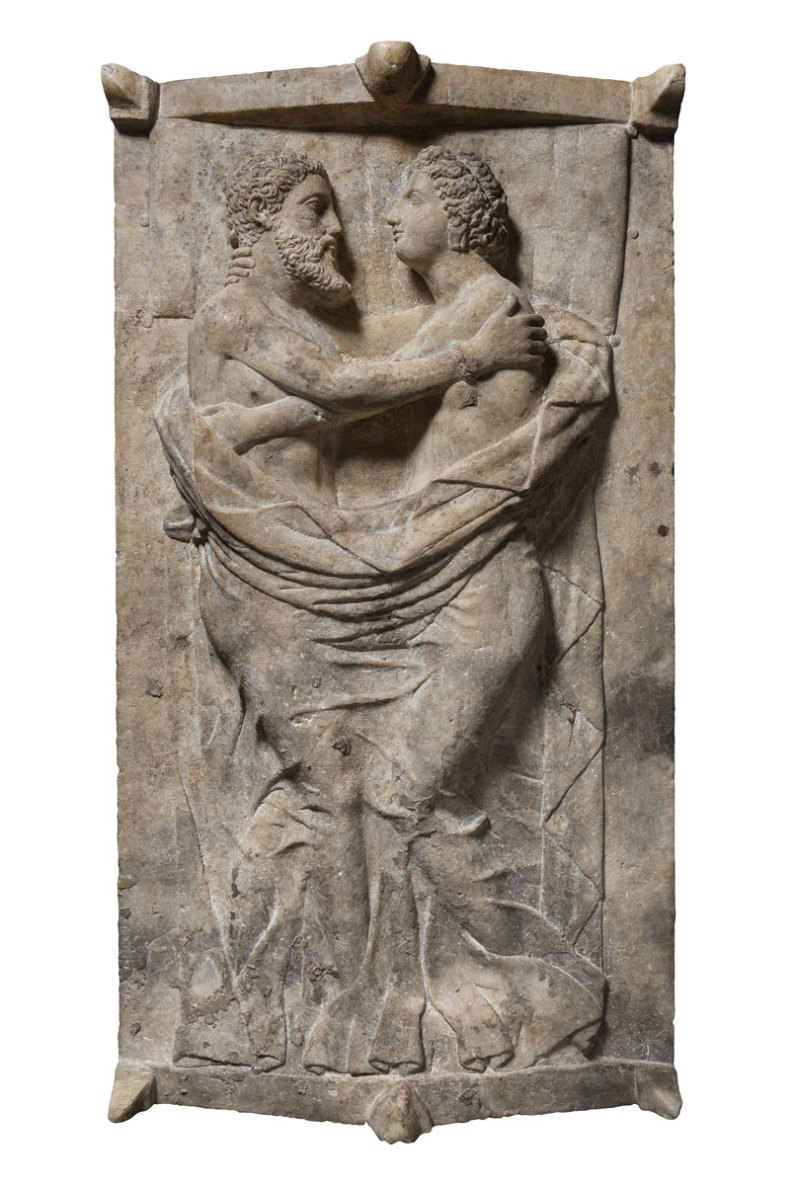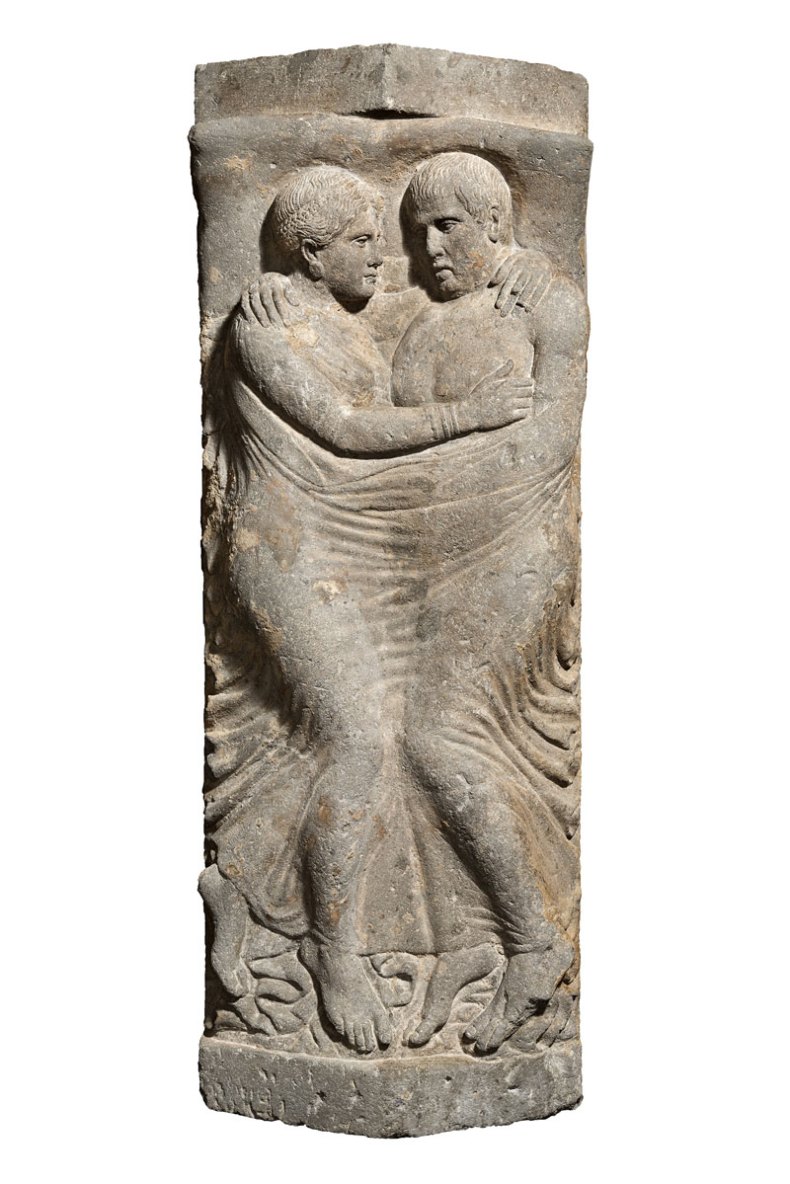In recent years, as the museum world has pursued a more visitor-centered, less art-historical approach to bringing art and people together, its professionals have found new ways to engage existing and potential audiences more deeply than ever before. What interests me, as a curator of ancient art, is what we can learn about ourselves by considering old objects in new lights.
From 2011 to 2013, as part of my work at the Museum of Fine Arts, Boston, I was involved in a conservation project led by conservator Mei-An Tsu, which cleaned and stabilised a pair of Etruscan stone sarcophagi unearthed in 1846 in a tomb in Vulci, Italy (see this feature from Apollo’s February 2013 issue). Simultaneously, these compelling highlights of the MFA’s collection have been centerpieces of an innovative educational partnership with local hospitals which uses ‘art as a catalyst for discussions about the challenges and difficulties they [medical interns] face as physicians,’ (see Michael Blanding’s report in the Harvard Medicine Magazine for more information.) In consultation with their physician-educator colleagues, MFA educators Barbara Martin and Brooke DiGiovanni Evans lead first-year residents through exercises that sharpen their capacity for close looking and facilitate conversations around empathy and self-care. There are similar programmes at other US medical schools (Yale, Columbia and Brown, to name a few), all of which recognise the academic and humanistic benefits of analysing and interpreting works of art in training the next generation of doctors.

Sarcophagus and lid with husband and wife (350–300 BC), Etruscan; Travertine. Photo © Museum of Fine Arts, Boston
What better works of art to illustrate this point than the poignant images of married couples embracing for eternity on the lids of these sarcophagi? Death is a constant presence for first-year residents, and families turn to them for support and wisdom. By the same token, anyone who has ever stood at the bedside of a dying relative or friend, or has empathy for someone who has had that heart-wrenching experience, is powerfully and forever affected by these images. When discussing the sarcophagi I always tend to stress the art-historical fact that the level of intimacy portrayed is unparalleled in Etruscan art (and Classical art in general) but in truth it is the intensely emotional response they elicit that places them among the favourite works in the MFA’s collection. The tenderly entwined couples carved in stone offer solace by reminding us that we are not the first or last to confront the death of a loved one.

Sarcophagus and lid with portraits of husband and wife (Late 4th–early 3rd century BC), Etruscan; Volcanic tuff. Photo © Museum of Fine Arts, Boston
And yet, more often than not works of art resonate with us for reasons different than the ones that motivated their creation or informed their original reception – and we should make our best effort not to conflate the two. The fact that we are sentimental about the marital love (we think is) portrayed on the coffin lids has everything to do with modern notions about romantic love as a prerequisite for marriage, and very little to do with how Arnth Tetnies and Ramtha Vishnai actually felt about each other. The elite Tetnies family, who commissioned the sarcophagi and enacted the funeral rituals in which they played a crucial and lasting role, may not have seen them as couples ‘in love’ as we know it. There is every reason to believe that what they valued most was the image of an idealised marriage and the social status it brought rather than the emotional connectedness we read into the image. This would be no less true of a tender portrait of a modern power couple rumoured to have marital troubles.
Our collective inclination to see marital harmony and love is legitimate but we should claim it as our own rather than projecting it onto people in the distant past whose relationships and emotions are not known to us. Confronting the reasons why these images move us so – the longing for romantic love, the ever-diminishing supply of empathy and the end-of-life issues arising from advances in modern medicine among them – can bring us a richer understanding of our own values and is a most welcome use of ancient art.

What can two Etruscan sarcophagi teach us about ourselves?
Sarcophagus and lid with portraits of husband and wife (detail; late 4th–early 3rd century BC), Etruscan; Volcanic tuff. Photo © Museum of Fine Arts, Boston
Share
In recent years, as the museum world has pursued a more visitor-centered, less art-historical approach to bringing art and people together, its professionals have found new ways to engage existing and potential audiences more deeply than ever before. What interests me, as a curator of ancient art, is what we can learn about ourselves by considering old objects in new lights.
From 2011 to 2013, as part of my work at the Museum of Fine Arts, Boston, I was involved in a conservation project led by conservator Mei-An Tsu, which cleaned and stabilised a pair of Etruscan stone sarcophagi unearthed in 1846 in a tomb in Vulci, Italy (see this feature from Apollo’s February 2013 issue). Simultaneously, these compelling highlights of the MFA’s collection have been centerpieces of an innovative educational partnership with local hospitals which uses ‘art as a catalyst for discussions about the challenges and difficulties they [medical interns] face as physicians,’ (see Michael Blanding’s report in the Harvard Medicine Magazine for more information.) In consultation with their physician-educator colleagues, MFA educators Barbara Martin and Brooke DiGiovanni Evans lead first-year residents through exercises that sharpen their capacity for close looking and facilitate conversations around empathy and self-care. There are similar programmes at other US medical schools (Yale, Columbia and Brown, to name a few), all of which recognise the academic and humanistic benefits of analysing and interpreting works of art in training the next generation of doctors.
Sarcophagus and lid with husband and wife (350–300 BC), Etruscan; Travertine. Photo © Museum of Fine Arts, Boston
What better works of art to illustrate this point than the poignant images of married couples embracing for eternity on the lids of these sarcophagi? Death is a constant presence for first-year residents, and families turn to them for support and wisdom. By the same token, anyone who has ever stood at the bedside of a dying relative or friend, or has empathy for someone who has had that heart-wrenching experience, is powerfully and forever affected by these images. When discussing the sarcophagi I always tend to stress the art-historical fact that the level of intimacy portrayed is unparalleled in Etruscan art (and Classical art in general) but in truth it is the intensely emotional response they elicit that places them among the favourite works in the MFA’s collection. The tenderly entwined couples carved in stone offer solace by reminding us that we are not the first or last to confront the death of a loved one.
Sarcophagus and lid with portraits of husband and wife (Late 4th–early 3rd century BC), Etruscan; Volcanic tuff. Photo © Museum of Fine Arts, Boston
And yet, more often than not works of art resonate with us for reasons different than the ones that motivated their creation or informed their original reception – and we should make our best effort not to conflate the two. The fact that we are sentimental about the marital love (we think is) portrayed on the coffin lids has everything to do with modern notions about romantic love as a prerequisite for marriage, and very little to do with how Arnth Tetnies and Ramtha Vishnai actually felt about each other. The elite Tetnies family, who commissioned the sarcophagi and enacted the funeral rituals in which they played a crucial and lasting role, may not have seen them as couples ‘in love’ as we know it. There is every reason to believe that what they valued most was the image of an idealised marriage and the social status it brought rather than the emotional connectedness we read into the image. This would be no less true of a tender portrait of a modern power couple rumoured to have marital troubles.
Our collective inclination to see marital harmony and love is legitimate but we should claim it as our own rather than projecting it onto people in the distant past whose relationships and emotions are not known to us. Confronting the reasons why these images move us so – the longing for romantic love, the ever-diminishing supply of empathy and the end-of-life issues arising from advances in modern medicine among them – can bring us a richer understanding of our own values and is a most welcome use of ancient art.
Unlimited access from just $16 every 3 months
Subscribe to get unlimited and exclusive access to the top art stories, interviews and exhibition reviews.
Share
Recommended for you
The eternal embrace: conserving the Tetnies sarcophagi
In July 2011, the Museum of Fine Arts (MFA), Boston, embarked on a two-year project to conserve two of its…
Don’t look back? 100 Hours of close looking at UCL
How do you look at an unfamiliar object? A recent project at UCL gave researchers plenty of time to consider
Looking Good: National Gallery exhibitions promote close looking
‘Making Colour’ and ‘Building the Picture’ point out details in paintings that are easily overlooked